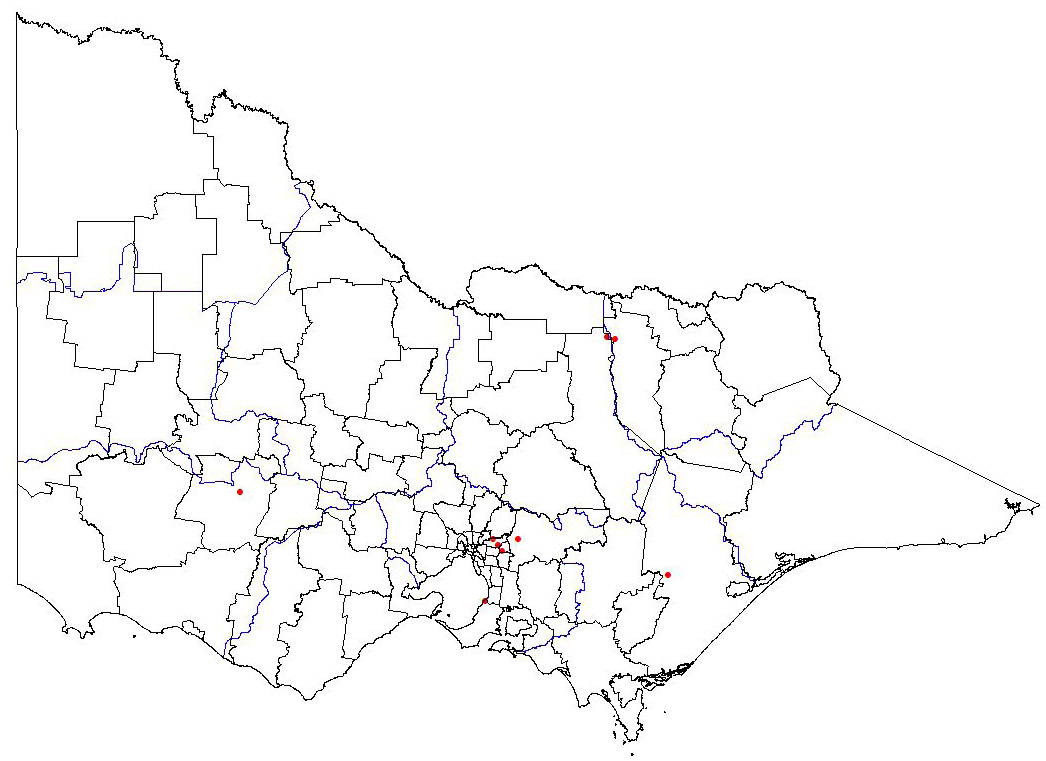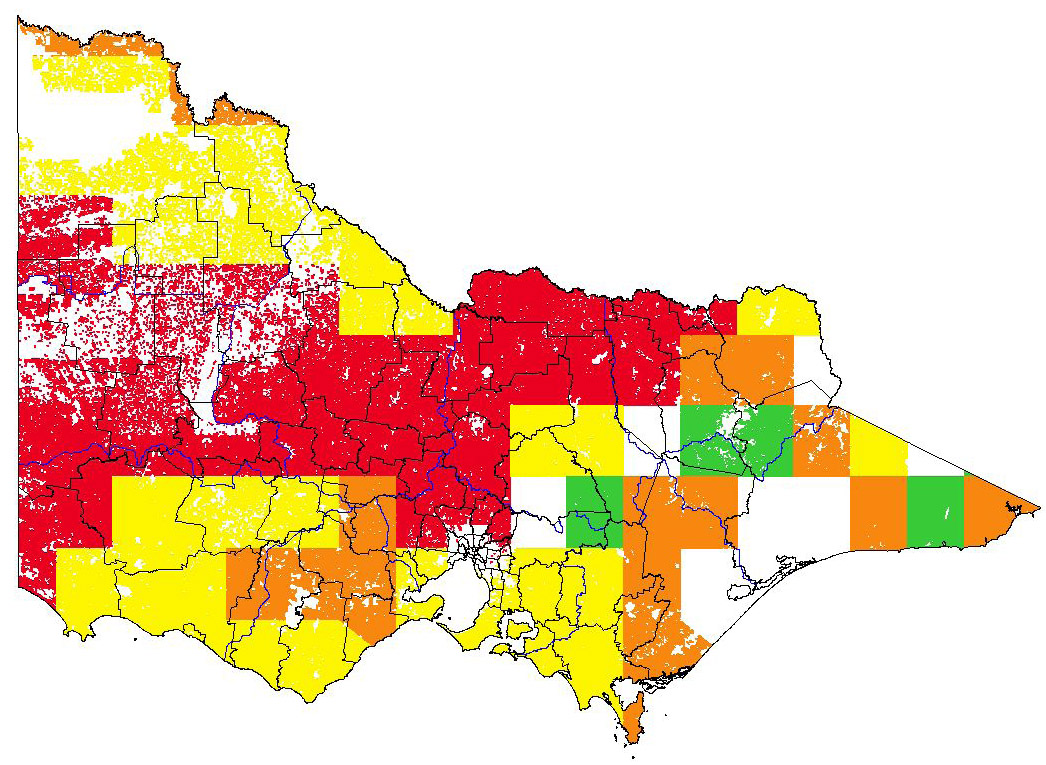Baboon flower (Babiana angustifolia)
Present distribution
|  Map showing the present distribution of this weed. | ||||
| Habitat: Gravel soils, sand, loams clay and wet soils in winter (Spooner et al. 2008). ‘Seasonally damp clay flats and lower slopes…’ (Pacific Bulb Society 2009). Grows amongst medium sized trees, grasslands, dunes, slopes, roadsides, waste areas and disturbed natural vegetation (Spooner et al. 2008). | |||||
Potential distribution
Potential distribution produced from CLIMATE modelling refined by applying suitable landuse and vegetation type overlays with CMA boundaries
| Map Overlays Used Land Use: Broadacre cropping; forestry; horticulture perennial; horticulture seasonal; pasture dryland; pasture irrigation; water Ecological Vegetation Divisions Coastal; heathland; grassy/heathy dry forest; swampy scrub; freshwater wetland (permanent); treed swampy wetland; lowland forest; foothills forest; forby forest; damp forest; riparian; wet forest; rainforest; high altitude shrubland/woodland; high altitude wetland; alpine treeless; granitic hillslopes; rocky outcrop shrubland; western plains woodland; basalt grassland; alluvial plains grassland; semi-arid woodland; alluvial plains woodland; ironbark/box; riverine woodland/forest; freshwater wetland (ephemeral); saline wetland; chenopod shrubland; chenopod mallee; hummock-grass mallee; lowan mallee; broombush whipstick Colours indicate possibility of Babiana angustifolia infesting these areas. In the non-coloured areas the plant is unlikely to establish as the climate, soil or landuse is not presently suitable. | 
|
Impact
QUESTION | COMMENTS | RATING | CONFIDENCE |
| Social | |||
| 1. Restrict human access? | Perennial herb to 30cm (Dave’s Garden undated). Small sized plants unlikely to restrict access. - Minimal or negligible impact. (i.e. can go anywhere). | l | ml |
| 2. Reduce tourism? | Perennial herb to 30cm (Dave’s Garden undated). Blooming late in winter/early spring, flowers are red, purple violet or blue (Spooner et al. 2008; Pacific Bulb Society 2009). Small herb with bright coloured flowers, unlikely to cause great impacts on tourism, but may have a small visual impact if blooms are in clumps. - Little or negligible impact on aesthetics or structure of site. | l | ml |
| 3. Injurious to people? | No evidence of injurious characteristics. - No effect, no prickles, no injuries. | l | l |
| 4. Damage to cultural sites? | Perennial herb to 30cm (Dave’s Garden undated). Flowers are red, purple violet or blue (Spooner et al. 2008; Pacific Bulb Society 2009). - Potential moderate visual effect, | ml | ml |
| Abiotic | |||
| 5. Impact flow? | Not an aquatic weed, or found in riparian areas. Unlikely to impact flows. - Little or negligible affect on water flow. | l | l |
| 6. Impact water quality? | Not an aquatic weed, or found in riparian areas. Unlikely to impact water quality. - No noticeable effect on dissolved O2 or light levels. | l | l |
| 7. Increase soil erosion? | Perenial cormous herbs, aerial parts die back annually, corms with fibrous tunics (Flora Zambesiaca 2004). Corms with ‘fibrous tunic’ may increase soil stability around this plant, but above ground parts dying each year may reduce soil stability. - Moderate possibility of large scale soil movement. | ml | m |
| 8. Reduce biomass? | Perenial cormous herbs, aerial parts die back annually, corms with fibrous tunics (Flora Zambesiaca 2004). Biomass should not decrease in the presence of Babiana angustifolia. - Biomass may increase. | l | ml |
| 9. Change fire regime? | Unknown. | m | l |
| Community Habitat | |||
| 10. Impact on composition (a) high value EVC | EVC = Floodplain Riparian Woodland (V); CMA = North Central; Bioregion = Victorian Riverina; VH CLIMATE potential. Perennial herb to 30cm (Dave’s Garden undated). - Minor displacement of some dominant or indicator species within any one layer/strata. | ml | h |
| (b) medium value EVC | EVC = Box Ironbark (D); CMA = Goulburn Broken; Bioregion = Goldfields; VH CLIMATE potential. Perennial herb to 30cm (Dave’s Garden undated). - Minor displacement of some dominant or indicator species within any one layer/strata. | ml | h |
| (c) low value EVC | EVC = Damp Forest (LC); CMA = Goulburn Broken; Bioregion = Highlands Northern Fall; VH CLIMATE potential. Perennial herb to 30cm (Dave’s Garden undated). - Minor displacement of some dominant or indicator species within any one layer/strata. | ml | h |
| 11. Impact on structure? | Perennial herb to 30cm (Dave’s Garden undated). - Minor or negligible effect on <20% of the floral strata/layers present; usually only affecting one of the strata. | l | ml |
| 12. Effect on threatened flora? | Perennial herb to 30cm (Dave’s Garden undated). Impacts of B. angustifolia upon threatened flora are unknown. | mh | l |
| Fauna | |||
| 13. Effect on threatened fauna? | Perennial herb to 30cm (Dave’s Garden undated). Impacts of B, angustifolia upon threatened fauna are unknown. | mh | ml |
| 14. Effect on non-threatened fauna? | Perennial herb to 30cm (Dave’s Garden undated). Potential to provide shelter. Unknown if Babiana angustifolia is palatable. - No fauna affected due to fauna not coexisting within weed area or strata. | l | ml |
| 15. Benefits fauna? | Perennial herb to 30cm (Dave’s Garden undated); potential to provide shelter. - Provides very little assistance to desirable species. | h | ml |
| 16. Injurious to fauna? | No injurious characteristics. - No effect. | l | ml |
| Pest Animal | |||
| 17. Food source to pests? | Unknown. | m | l |
| 18. Provides harbor? | Perennial herb to 30cm (Dave’s Garden undated). Small size of this plant will provide minimal harbour for pest species. - No harbour for pest species. | l | ml |
| Agriculture | |||
| 19. Impact yield? | Babiana angustifolia is not known to be a weed of agriculture (Randall 2007), therefore yields are unlikely to be affected. - Little impact on quantity of yield. | l | m |
| 20. Impact quality? | Babiana angustifolia is not known to be a weed of agriculture (Randall 2007), therefore quality are unlikely to be affected. - Little impact on quality of yield. | l | m |
| 21. Affect land value? | Babiana angustifolia is not known to be a weed of agriculture (Randall 2007), therefore yields are unlikely impact land values. - Little or none. | l | m |
| 22. Change land use? | Babiana angustifolia is not known to be a weed of agriculture (Randall 2007), therefore there is minimal possibility of changes in land use. - Little or no change. | l | m |
| 23. Increase harvest costs? | Babiana angustifolia is not known to be a weed of agriculture (Randall 2007), therefore harvesting times and costs are unlikely to change. - Little or none. | l | m |
| 24. Disease host/vector? | Brunt et al. (1996 onwards) do not list Babiana angustifolia as a host to disease or viruses. - Little or no host. | l | mh |
Invasive
QUESTION | COMMENTS | RATING | CONFIDENCE |
| Establishment | |||
| 1. Germination requirements? | Gravel soils, sand, loams clay and wet soils in winter (Spooner et al. 2008). - Requires natural seasonal disturbances, such as seasonal rainfall. | mh | mh |
| 2. Establishment requirements? | Gravel soils, sand, loams clay and wet soils in winter (Spooner et al. 2008). ‘Seasonally damp clay flats and lower slopes…’ (Pacific Bulb Society 2009). Grows amongst medium sized trees, grasslands, dunes, slopes, roadsides, waste areas and disturbed natural vegetation (Spooner et al. 2008) - Requires more specific requirements to establish (e.g. open space, bare ground with access to light and direct rainfall). | ml | m |
| 3. How much disturbance is required? | Grows amongst medium sized trees, grasslands, dunes, slopes, roadsides, waste areas and disturbed natural vegetation (Spooner et al. 2008) - Requires more specific requirements to establish (e.g. open space or bare ground with access to light and direct rainfall). | ml | m |
| Growth/Competitive | |||
| 4. Life form? | Broad leaved herb (Spooner et al. 2008). - Other. | L | m |
| 5. Allelopathic properties? | None described in Rice (1984). - None | l | mh |
| 6. Tolerates herb pressure? | Unknown. | m | l |
| 7. Normal growth rate? | Unknown. | m | l |
| 8. Stress tolerance to frost, drought, w/logg, sal. etc? | Grows on wet soils in winter (Spooner et al. 2008), and seasonally damp clay flats (Pacific Bulbs Society 2009) possibly indicating tolerance of water logging. - May be tolerant of one stress, susceptible to at least two. | l | m |
| Reproduction | |||
| 9. Reproductive system | Reproduction is via seed, and offsets (Brown and Brooks 2002). - Both vegetative and sexual reproduction. | h | mh |
| 10. Number of propagules produced? | Three cells in each ovary, each with 20-50 ovules (seeds) (Spooner et al 2008). - 50-1000. | ml | m |
| 11. Propagule longevity? | Unknown. | m | l |
| 12. Reproductive period? | Annual leaves and stems, perennial corm (Spooner et al. 2008). - Mature plant produces viable propagules for 3-10 years. | mh | m |
| 13. Time to reproductive maturity? | Annual leaves and stems, perennial corm (Spooner et al. 2008). - Produces propagules between 1-2 years after germination, or vegetative propagules become separate individuals between 1-2 years. | mh | m |
| Dispersal | |||
| 14. Number of mechanisms? | Unknown. | m | l |
| 15. How far do they disperse? | Unknown. | m | l |
References
Brunt AA, Crabtree K, Dallwitz MJ, Gibbs AJ, Watson L, Zurcher EJ (eds.) (1996 onwards) Plant Viruses Online: Descriptions and Lists from the VIDE Database. Version 20th August 1996. Available at http://biology.anu.edu.au/Groups/MES/vide/ (verified 05 May 2009).
Dave’s Garden (2000-2009) Baboon Flower Babiana angustifolia. Available at http://davesgarden.com/guides/pf/go/78654/ (verified 06 May 2009).
Flora Zambesiaca (2004) Taxon Detail Babiana. Available at http://apps.kew.org/efloras/namedetail.do?qry=namelist&flora=fz&taxon=9915&nameid=26291 (verified 06 May 2009)
Pacific Bulb Society (2009) Babiana Two. Available at http://www.pacificbulbsociety.org/pbswiki/index.php/Babiana (verified 06 May 2009).
Randall, R. (2007) A Global Compendium of Weeds On-line. Available at http://www.hear.org/gcw/ (verified 06 May 2009).
Rice EL (1984) Allelopathy. Academic Press, Inc. Orlando.
Spooner A, Carpenter J, Smith G, Spence K (2008) Babiana angustifolia Sweet, in FloraBase, the Western Australian Flora. Available at http://florabase.calm.wa.gov.au/browse/profile/18279 (verified 06 May 2009).
Global present distribution data references
Australian National Herbarium (ANH) (2008) Australia’s Virtual Herbarium, Australian National Herbarium, Centre for Plant Diversity and Research, Available at http://www.anbg.gov.au/avh/ (verified verified 06 May 2009).
Calflora: Information on California plants for education, research and conservation. [web application]. (2008) Berkeley, California: The Calflora Database [a non-profit organization]. Available at http://www.calflora.org/ (verified 06 May 2009).
Department of Sustainability and Environment (DSE) (2006) Flora information system [CD-ROM], Biodiversity and Natural Resources Section, Viridans Pty Ltd, Bentleigh.
EIS: Environmental Information System (2006) Parks Victoria.
Global Biodiversity Information Facility (GBIF) (2009) Global biodiversity information facility, Available at http://www.gbif.org/ (verified 06 May 2009).
IPMS: Integrated Pest Management System (2006) Department of Primary Industries.
Missouri Botanical Gardens (MBG) (2009) w3TROPICOS, Missouri Botanical Gardens Database, Available at http://mobot.mobot.org/W3T/Search/vast.html (verified 06 May 2009).
National Biodiversity Network (2008) NBN Gateway, National Biodiversity Network, UK, Available at http://www.searchnbn.net/index_homepage/index.jsp (verified 06 May 2009).
Feedback
Do you have additional information about this plant that will improve the quality of the assessment?
If so, we would value your contribution. Click on the link to go to the feedback form.


